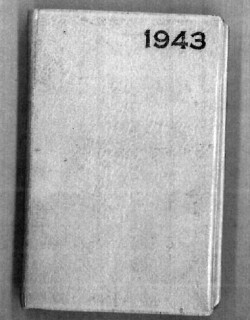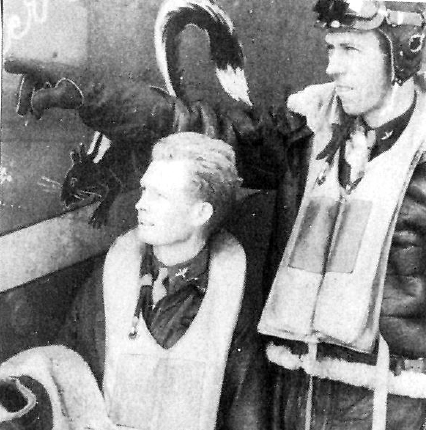“Got up early for a medal presentation, then it was called off. Had to wait until 0300 for breakfast. Spent the rest of the morning in bed. I’ve turned into quite a letter writer… Heard tonight that peace negotiations were going on between the States and the Allies.”

When he wrote these words on July 30, 1943, Capt. Jack Stanley Jones, a B-24 pilot, couldn’t possibly have imagined the journey they would take, or the joy they would bring to a family in 2014.
How could he? Little more than a day after he wrote them, he was dead.
It’s unclear whether Jones ever intended anyone to see them, or any of the other entries in the small, brown leather book embossed only with “1943.”
But his diary survived the years and the dusty trunks that sit in basements of the sons and daughters of the Greatest Generation, only to be reunited with its family thanks to a Roseville, Minn., couple and two strangers more than 1,000 miles apart who know a little something about genealogical sleuthing.
Jones, 24, flew a B-24 with the 93rd Bomb Group out of Benghazi, Libya. The 93rd was one of five bomb groups training in the desert to hit targets at very low altitudes. There was little in the diary about the reason why. Security for the mission was tight. Few of the crews of the 179 bombers that took off from Libya may have known that only half were expected to return.
It was “Black Sunday” — Aug. 1, 1943 — the day of the daring attack on the Ploesti oil fields of Romania, from where the Nazis got the oil to fuel a world war.
It was to be a daylight low-altitude bombing run using delayed fuse bombs, according to this account of the exploits of the 8th Air Force.
Each B-24 was heavily loaded with ammunition, bombs, and fuel as well as incendiary bombs to drop on the target. The mission was 2,400 miles round trip requiring the planes to stay airborne over 13 1/2 hours. The refineries were intensely defended by many large anti-aircraft batteries. Operation “Tidal Wave”, as it was called, was an extremely dangerous mission.
The groups became separated by bad weather over the Romanian Alps. The synchronized timing of the raid was ruined and the element of surprise was lost.
Between confused navigation, faulty bombs, and bad timing many bomber crews found themselves flying into total chaos over the target. At one point during the raid, B-24s were flying over one target area from 3 different directions. Observers on the ground said it was the greatest exhibition of flying skill they had ever seen.
They thought it was planned that way. Many aircraft were flying so low that they had to raise up to go over the power lines. Waist gunner, Don Pierce, recalled shooting up at anti-aircraft emplacements on the tops of buildings.
Capt. Jones wasn’t piloting the mission that day. He had already flown the 25 missions required before a pilot can go home. But he had some friends on the mission so he flew one more, this time as an observer.
His plane, dubbed “Exterminator,” crashed in the mountains of Bulgaria, killing all aboard.
American intelligence had not discovered that the Germans had concentrated there the largest flack field of any aerial defense system they mustered during the war. German artillery was hidden in haystacks, church steeples and freight trains.
Officially, the mission was a success. Thirty percent of the Nazis’ oil supply was cut, but only for a few months. Of the 178 planes in the bomb groups, 54 didn’t return; 446 men died. Five Medals of Honor were presented to men in the mission; three of them received it posthumously.

Capt. Charles T. Merrill, an Iowa lad and commander of Jones’ group, was one of the lucky ones. Low on fuel, he landed the “Thar She Blows Again” back at Libya, and learned that his colleague’s ship had been lost.

Capt. Merrill retired as a full colonel in the Air Force, moving from assignment to assignment. When he died in 2002, the trunks containing his military life moved to the Roseville, Minn., basement of his daughter and son-in-law, Carolyn and Larry Woods.
It wasn’t until several years after his death that they looked inside one of the trunks and discovered the last evidence of Capt. Jones.
“We found a leather-bound diary and on the front it just said, ‘1943,’ so we started reading it,” Carolyn said. “But it wasn’t my dad’s writing. It had beautiful writing.”
“The diary wrote down the names of people he would fly with, and in the last entry noted he got a letter from Iva Jewell,” Larry said, not willing to reveal the contents of the diary out of respect for the family of its author. “He wrote every day. He had great handwriting and it hadn’t faded at all. But then it stopped on July 30, 1943.”
The couple didn’t think much more about the diary for a time — finding someone named “Jones” after 70 years didn’t seem like a possibility.
“We thought, ‘wouldn’t it be fun to try to find a family member?'” Larry Woods recalled. “But it was like finding a needle in a haystack, someone named Jones in Louisiana.”
Having no luck, Larry handed the diary to Jack Thueson, a Minnesota Department of Human Services colleague and genealogy lover. Thueson put the word out on Ancestry.com. It took only a few weeks to find the surviving kin of Capt. Jones.
At the other end of the genealogical hunt was Clint Casanova, Jones’ great nephew who still lives in Franklinton, La., and had been researching the family.
After verifying that the Casanovas were the diary’s rightful heirs , the diary was shipped from Minnesota to Louisiana in time to be a Father’s Day present for Clint’s father, Karl.
“I grew up hearing the story of Stanley,” Karl said in a recent interview. “My mother was his sister and she was 9 when he was killed.”

The stories were family legend. “When he was stationed down here,” Karl said, “he would announce he was in the area by dropping this big, four-engine B-24 down low over the pasture to let them know he’d be visiting.”
The diary was a treasured present for sure, but it came with melancholy: His mother — Capt. Jones’ sister — died in 2012.
“I got to see a side of him that I wouldn’t have otherwise heard,” Karl said, noting that the small marker honoring Capt. Jones still st ands just outside the church he attends regularly. “It’s the diary of a young serviceman, living away from home for the first time, apart from a very conservative, rural family. You can see the trials he was going through and the joys of growing up. He talked about going to the movies; it was all in there.”
One significant mystery remains: Why did Col. Merrill have Capt. Jones’ diary?
“He was the kind of person who liked to connect with people,” his daughter, Carolyn, said. “He’d catch up with people he met in college… he was always connecting. I think it was because he was an only child; it was his passion. I think after the raid, he intended to send the diary to his family and somehow he just forgot about it.”
“It may have been a small item in a trunk, but it was important to him,” she said.
And maybe that’s just as well, Karl Casanova says. “Maybe it wasn’t meant for his close family to see his diary. There were a few things you wouldn’t write home and tell mom. It was difficult to read.”
There are more trunks in the Woods’ basement and, they think, more treasures. One of these days, they’ll take another look inside.
